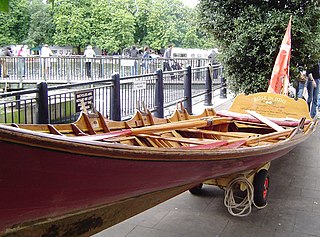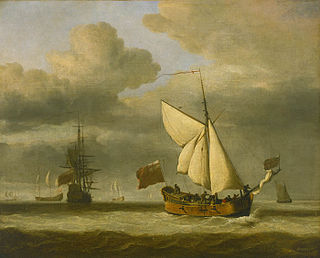
A wherry is a type of boat that was traditionally used for carrying cargo or passengers on rivers and canals in England, and is particularly associated with the River Thames and the River Cam. They were also used on the Broadland rivers of Norfolk and Suffolk.

The River Tyne is a river in North East England. Its length is 73 miles (118 km). It is formed by the North Tyne and the South Tyne, which converge at Warden Rock near Hexham in Northumberland at a place dubbed 'The Meeting of the Waters'.

Sunderland is a port city in Tyne and Wear, England. It is a port at the mouth of the River Wear on the North Sea, approximately 10 miles (16 km) south-east of Newcastle upon Tyne. The built-up area had a population of 168,277 at the 2021 census, making it the second largest settlement in North East England after Newcastle. It is the administrative centre of the metropolitan borough of the same name.

Tyneside is a built-up area across the banks of the River Tyne in Northern England. Residents of the area are commonly referred to as Geordies. The whole area is surrounded by the North East Green Belt.
Killingworth, formerly Killingworth Township, is a town in North Tyneside, Tyne and Wear, England. It lies within the historic county of Northumberland.

RMS Mauretania was a British ocean liner designed by Leonard Peskett and built by Swan Hunter and Wigham Richardson on the River Tyne, England for the Cunard Line, launched on the afternoon of 20 September 1906. She was the world's largest ship until the launch of RMS Olympic in 1910. Mauretania captured the eastbound Blue Riband on the maiden return voyage in December 1907, then claimed the westbound Blue Riband for the fastest transatlantic crossing during her 1909 season. She held both speed records for 20 years.

The North Tyneside Steam Railway and Stephenson Steam Railway are visitor attractions in North Shields, North East England. The museum and railway workshops share a building on Middle Engine Lane adjacent to the Silverlink Retail Park. The railway is a standard gauge line, running south for 2 miles (3.2 km) from the museum to Percy Main. The railway is operated by the North Tyneside Steam Railway Association (NTSRA). The museum is managed by Tyne and Wear Archives and Museums on behalf of North Tyneside Council.

The history of Newcastle upon Tyne dates back almost 2,000 years, during which it has been controlled by the Romans, the Angles and the Norsemen amongst others. Newcastle upon Tyne was originally known by its Roman name Pons Aelius. The name "Newcastle" has been used since the Norman Conquest of England. Due to its prime location on the River Tyne, the town developed greatly during the Middle Ages and it was to play a major role in the Industrial Revolution, being granted city status in 1882. Today, the city is a major retail, commercial and cultural centre.

East Indiaman was a general name for any merchant ship operating under charter or licence to any of the East India companies of the major European trading powers of the 17th through the 19th centuries. The term is used to refer to vessels belonging to the Austrian, Danish, Dutch, British, French, Portuguese or Swedish East India companies.

Tyne Dock is a neighbourhood within the town of South Shields, Tyne and Wear, on the south bank of the River Tyne. It takes its name from the large dock on the river which was opened in 1859 by the North Eastern Railway to handle Tyneside's coal exports. At its height the trade amounted to seven million tons of coal transported via the four staiths which had been built to facilitate the process. This trade declined in the second half of the twentieth century and the bridges that carried the coal trains into the dock, the famous Tyne Dock Arches, were demolished from 1977 on. The dock itself has been progressively infilled since closure, allowing for the building of modern storage warehouses. This process concluded with the final 13 acres that were filled in as part of the project to build the second Tyne Tunnel. The Tyne Dock basin was filled with 400,000 cubic metres of sediment dredged from the Tyne.
Westerhope is an area in the west of Newcastle upon Tyne, England. It was founded to provide housing for working families with sufficient land to grow vegetables. Westerhope expanded substantially in Victorian times with the discovery of workable coal reserves. It was also formerly a ward of the city council until 2018, which had a population of 9,196 at the 2011 Census. The coal reserves have now been largely exhausted and the two pits - Coronation & North Walbottle - have long since closed. After the extraction of 21.5 million tons of coal, the North Walbottle pit was closed in 1968 as further coal extraction would have risked undermining the runway of Newcastle airport, which lies about 5 miles to the North.

The Incorporated Company of Hostmen of Newcastle upon Tyne, often called the Hostmen's Company of Newcastle, is a company incorporated by royal charter of 22 March 1599/1600. Analogous to a livery company of the City of London, it still exists. It is best known to economic historians as a cartel of businessmen who formed a monopoly to control the export of coal from the River Tyne in North East England. They were so known from the medieval practice of "hosting", whereby local businessmen provided visiting merchants with accommodation and introduced them to local traders. The Hostmen acted as middlemen with whom the coal producers and those who shipped the coal to London and elsewhere were forced to deal.
The Keelmen of Tyne and Wear were a group of men who worked on the keels, large boats that carried the coal from the banks of both rivers to the waiting collier ships. Because of the shallowness of both rivers, it was difficult for ships of any significant draught to move up river and load with coal from the place where the coal reached the riverside. Thus the need for shallow-draught keels to transport the coal to the waiting ships. The keelmen formed a close-knit and colourful community on both rivers until their eventual demise late in the nineteenth century.

A collier is a bulk cargo ship designed or used to carry coal. Early evidence of coal being transported by sea includes use of coal in London in 1306. In the fourteenth and fifteenth centuries, coal was shipped from the River Tyne to London and other destinations. Other ports also exported coal – for instance the Old Quay in Whitehaven harbour was built in 1634 for the loading of coal. London became highly reliant on the delivery of coal by sea – Samuel Pepys expressed concern in the winter of 1666–67 that war with the Dutch would prevent a fleet of 200 colliers getting through. In 1795, 4,395 cargoes of coal were delivered to London. By 1824, this number had risen to about 7,000; by 1839, it was over 9,000. The trade continued to the end of the twentieth century, with the last cargo of coal leaving the Port of Tyne in February, 2021.
The Stanhope and Tyne Railway was an early British mineral railway that ran from Stanhope to South Shields at the mouth of the River Tyne in County Durham, England. It ran through the towns of Birtley, Chester Le Street, West Stanley and Consett. The object was to convey limestone from Stanhope and coal from West Consett and elsewhere to the Tyne, and to local consumers. Passengers were later carried on parts of the line.

Manors Power Station or the Tramways Generating Station is a former coal-fired power station located in the Manors district of the city centre of Newcastle upon Tyne, Tyne and Wear in North East England. The station's turbine hall and other remaining buildings are Grade II listed.
The Port of Tyne comprises the commercial docks on and around the River Tyne in Tyne and Wear in the northeast of England.
The geology of Tyne and Wear in northeast England largely consists of a suite of sedimentary rocks dating from the Carboniferous and Permian periods into which were intruded igneous dykes during the later Palaeogene Period.

Jim Mageean is an English folk singer based in Cullercoats, Tyne and Wear, England, specialising in Sea Shanties, traditional maritime music and "Geordie" songs from his native North East of England.
HMS Surly was a Cheerful-class cutter built in 1806. Carrying 12 guns she served during the Napoleonic Wars and helped to capture a French privateer in 1809. In 1825 she was employed in carrying quantities of coin between Dublin and London and also in suppressing strike action by seamen on the River Wear. Her duties assisting the civil authorities at the Wear and later on the River Tyne extended into 1827. Surly later served on the Scottish coast and on anti-smuggling patrols in the Thames Estuary. She was refitted as a lighter in 1833 and sold out of service in 1837.












